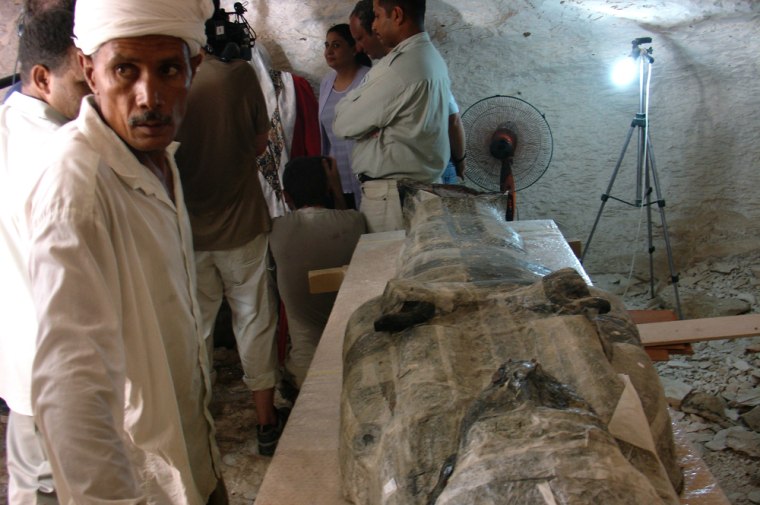Archaeologists on Wednesday fully unveiled the first ancient chamber discovered in Egypt's Valley of the Kings in more than 80 years, and cracked open the last of seven sarcophagi inside to reveal embalming materials and jewelry.
"This is even better than finding a mummy — it's a treasure," said chief curator Nadia Lokma, beaming at the sarcophagus packed with fragile remains that would crumble into dust if touched.
"It will tell us about the religious plants and herbs used by ancient Egyptians, what they wore, how they wove it, how they embalmed the dead," she said.
Dug deep into the white rock, the chamber is known only by the acronym KV63 — the 63rd tomb found in the Valley — and was discovered accidentally last year by U.S. archaeologists working on the neighboring tomb of Amenmeses, a late 19th Dynasty pharaoh.
It is believed to be more than 3,000 years old.
Scientists cut a hole in the chamber's door and got their first glimpse into the 12-by-15-foot (2.5-by-4.5 meter) tomb in February. But Wednesday was the first time researchers and media were free to walk into the small square pit.
Dozens cram into room
Dozens of researchers and media excitedly crammed into the site Wednesday to watch officials crack open the last of seven sarcophagi found inside. Instead of the expected mummy, the coffin revealed embalming materials, dozens of necklaces made from woven flowers and various other religious artifacts.
Covered in resin cast to their owner's faces, all seven coffins were empty of bodies. Instead of mummies, they were found to contain mostly pottery shards. One small sarcophagus, made for a baby, contained pillows that appeared to be stuffed with feathers.
But Lokma hoped hieroglyphs would help scientists identify who the coffins were made for, and perhaps where the bodies were ultimately buried.
Heavily damaged sarcophagi
Termites and possibly ancient tomb robbers had damaged the sarcophagi so much that it took months of labor for archaeologists to excavate them. Sixteen of the 28 funeral jars found in the tomb have yet to be opened.
The tomb's discovery last year broke the long-held belief that nothing is left to dig up in the Valley of the Kings, the desert region near the southern city of Luxor used as a burial ground for pharaohs, queens and nobles in the 1500-1000 B.C. New Kingdom.
The last tomb discovered there was the famed King Tut's, in 1922.
Was it a tomb for Tut's mom?
Zahi Hawass, who heads the Egyptian Supreme Council of Antiquities, said he believed the new tomb could have belonged to King Tutankhamen's mother. Closely related Egyptian royals tended to be buried near each other, and graves of the rest of Tut's family have already been found, he said.
"It would make sense, his tomb is so close that it looks like he chose to be buried next to his mother," who died years before the young king, Hawass said.
Though the new discovery did not compare with the marvels of golden masks, jewels and statues found in Tut's tomb, Hawass said it was a major scientific discovery and one that could boost tourism to Egypt.
Tourism to the pharaohs' archaeological sites has boomed since an exhibition of Tut's treasures began touring foreign museums. The display, currently in Chicago, has brought the largest number of Americans to Egypt, Hawass said.
"King Tut and new discoveries are our best publicity," he said.
